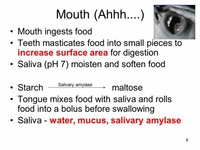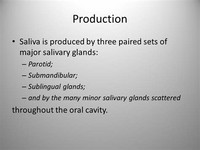Facts about Saliva

Human saliva is composed mostly of water, about 98 to 99 percent, but also includes dissolved inorganic ions and numerous organic substances, including proteins, such as mucins (heavily glycosylated proteins) (Orchardson 2001).

The digestive functions of saliva include breaking down components of food, moistening food, and helping to create a food bolus, so it can be swallowed easily.

Insufficient salivary flow can increase incidence of dental disease (dental caries and periodontal disease) and disease of the oral mucosa (Orchardson 2001).

Researchers at the University of Florida at Gainesville have discovered a protein called nerve growth factor (NGF) in the saliva of mice.

Some swifts use their gummy saliva to build their nests, and some Aerodramus swiftlet nests are made only from saliva (and used to make bird's nest soup) (Marcone 2005).

Lack of sufficient saliva may result in increased dental disease, disease of the oral mucosa, and difficulty in chewing, speaking, and swallowing.

Some arthropods, such as spiders and caterpillars, create thread from salivary glands.

Saliva also contains growth factors that promote healing of the oral mucosa, and contains various antimicrobial substances, including lysozyme, lactoferrin, histatins, and specific antibodies, such as secretory immunoglobin A, which binds to bacterial antigens.

Cotton swabs coated with saliva are rolled across a paintings surface to delicately remove thin layers of dirt that may accumulate (Gavett 2008).

Saliva typically in humans is stimulated by the physical activity of chewing, or even by the thought of food; olfactory stimuli have little effect, although irritants such as spices can elicit flow (Orchardson 2001).

Saliva is complex fluid, of watery or viscous consistency, produced in and secreted from the major and minor salivary glands in the mouths of humans and most other animals.

The parsympathetic nerves, when activated, stimulate large amounts of a watery saliva with ions and enzymes, while activation of the sympathetic nerves produces small amounts of protein-rich saliva (Orchardson 2001).

Saliva also assists in swallowing by moistening ingested food, has proteins that provide a barrier against bacteria, fungi, and viruses, and has anti-micobrial substances that likewise protect the body.

Salivary glands also secrete enzymes (salivary lipase) to start fat digestion (Maton et al.

Human saliva is produced by the three pairs of major salivary glands (parotid, submandibular, and sublingual glands) and the many minor salivary glands.

The average person produces a total of about 600 milliliters of saliva per day from all the salivary glands in total (Orchardson 2001).

Wounds doused with NGF healed twice as fast as untreated and unlicked wounds; therefore, saliva can help to heal wounds in some species.

Normally, with other horses we can keep all organs and the body for further study, or to preserve large specimens, like the heart, but I was not allowed to do this with Secretariat.

Human saliva contains the enzyme amylase that breaks some starches down into maltose and dextrin.

NGF has not been found in human saliva; however, researchers find human saliva contains such antibacterial agents as secretory IgA, lactoferrin, and lactoperoxidase.

A common belief is that saliva contained in the mouth has natural disinfectants, which leads people to believe it is beneficial to "lick their wounds."

Saliva even contributes to taste by dissolving sapid substances in food and making them more accessible to taste buds (Orchardson 2001).


